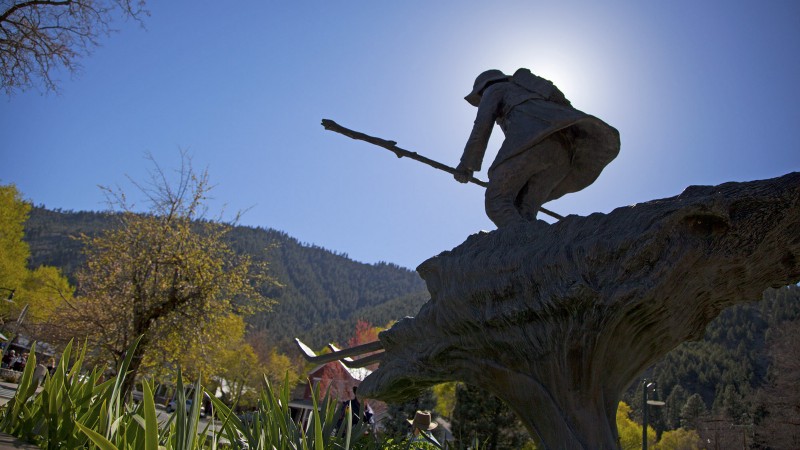A statue of Snowshoe Thompson in downtown Genoa. Travel Nevada/CC BY-NC-ND 2.0
Snowshoe Thompson was the Paul Bunyan of the Sierra Nevada
Two centuries ago, delivering mail across the icy Sierra Nevada was virtually impossible during the winter — until the arrival of a blonde-bearded Viking with piercing blue eyes and an uncommon fortitude.
John Thompson had immigrated with his family from Norway when he was 10 years old. Enticed west by the gold fields of California, he settled as a young man on a cattle farm in the Sacramento Valley.
In 1855, Thompson saw a newspaper article about the need for a mail carrier to reach people east of the Sierra range who were “lost to the world” during the snowbound months of winter. He offered his services.
Using memories of his Scandinavian boyhood, Thompson carved a pair of oak planks about seven feet in length that he secured to his feet with straps.

An undated portrait of Snowshoe Thompson.
Californians had never seen skis before. Friends warned him that he’d bash his head against a tree on the down slopes. Others, according to a newspaper account, “thought him demented.”
A crowd formed in the foothills town of Placerville to see him off on his first mail run in January 1856. Someone was said to shout, “Good luck, Snowshoe Thompson,” and the legend was born.
Thompson completed the route — about 90 miles from Placerville to Genoa, Nev., on the other side of Lake Tahoe — in a blisteringly fast three days. He continued the deliveries twice monthly for the next 20 years.
Tales of Thompson’s exploits grew to Paul Bunyan-like heights. He survived encounters with wolves, bears, and blizzards.
He carried no compass and no blanket, while his mailbag — including letters, medicines, and newspapers — weighed as much as 100 pounds. He drank water from mountain streams and camped under trees, using branches as a bed and the mailbag as a pillow.
One winter, Thompson entered a cabin to discover a wayward traveler on the verge of death, his “boots frozen to his feet.”
Thompson organized a rescue team, hauled the man to Genoa, then raced about 260 miles round trip to collect the medicine needed to amputate the patient’s feet. The operation was a success.

A statue of Snowshoe Thompson in downtown Genoa.
Travel Nevada/CC BY-NC-ND 2.0
Eventually, a rail line was established through the mountains, ending the need for Thompson’s mountain crossings.
Yet for all of his years of service, Thompson was never paid by the federal government. He once famously said, “If I do my job and get the mail to the people, Uncle Sam will pay me.” But he had never signed a contract with the U.S. Postal Service.
Thompson settled with his wife and son on a small ranch in Alpine County, where, on this week in 1876, he died from appendicitis. He was 49.
Though not widely known, Thompson is credited as the father of California skiing. He’s regarded as a hero in Norway and the communities of the Northern Sierra. Plaques and other markers in his honor are scattered throughout the mountain range, including a statue in Genoa, the city he gave a lifeline when no one else could.
Get your daily dose of the Golden State.